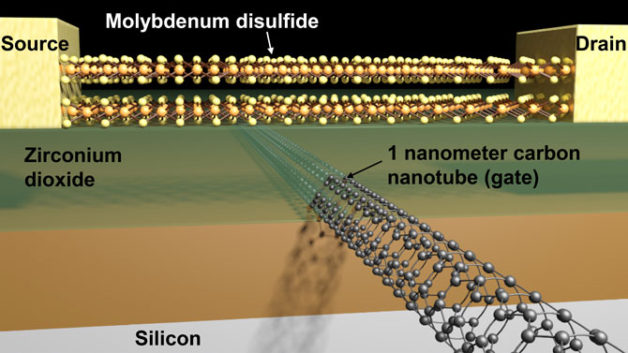
Oct. 7, 2016
By: Michael Feldman
As Moore’s Law reaches its physical limits with silicon-based semiconductor technology, researchers are turning to more exotic materials to extend its life a few more years. A team of scientists at Lawrence Berkeley National Laboratory (aka Berkeley Lab) did just that by inventing a one-nanometer (1nm) transistor.
Ali Javey, Berkeley Lab’s lead principal investigator in the Electronic Materials program, said the 1nm transistor he and his team created is the smallest ever devised. Using conventional materials, most semiconductor specialists believe the 5nm transistor is about as small as you can go before electronic leakage makes it impractical to operate silicon devices. The 5nm node isn’t expected to be commercially viable until at least 2020, and that assumes the remaining challenges for this technology can be solved. But according to Javey, by using different materials they’ve been able to demosntrate that “there is a lot more room to shrink our electronics.”
 Molybdenum disulfide channel and 1-nanometer carbon nanotube gate. (Credit: Sujay Desai/UC Berkeley)
Molybdenum disulfide channel and 1-nanometer carbon nanotube gate. (Credit: Sujay Desai/UC Berkeley)
In a nutshell, the Berkeley team employed molybdenum disulfide (MoS2) plus carbon nanotubes to create the transistor. The MoS2formed the bilayer gate, while a single-walled carbon nanotube served as the gate’s electrode. Due to different quantum mechanical properties than silicon, MoS2 is able to keep electrons flowing through smaller gates without them leaking out via tunneling. The researchers said they were able to observe excellent switching characteristics as well, with an on/off current ratio on the order of 106.
Currently, MoS2is mostly widely as an engine lubricant, but because it has excellent electronic and optical properties, it is thought to have a budding future in devices like lasers, solar cells, LED, and now, perhaps transistors. The work is still in the proof-of-concept stage. Someone still needs to figure out how these transistors can be mass produced at a reasonable cost in a commercial fab.
“But this work is important to show that we are no longer limited to a 5-nanometer gate for our transistors,” said Javey. “Moore’s Law can continue a while longer by proper engineering of the semiconductor material and device architecture.”
